From July 14 – October 1, the Whitney Museum of American of Art exhibited Hélio Oiticica: To Organize Delirium, a comprehensive display of Hélio Oiticica’s work created over the course of his career. A Brazilian artist associated with the Neo-Concrete movement, Oiticica (1937–1980) addressed the exoticization of Brazilian culture while also using his practice to speak against the corrupt and oppressive force of Brazil’s government. His early works reflect the influence of geometric abstraction, though over time he began to experiment with abstraction in sculpture and interactive installations. Notably, Oiticica’s most well-known installations Tropicália (1966–67) and Eden (1969) were included in the Whitney exhibition. Both works require activation by the viewer and envelop viewers in complete sensory experiences that are very much in line with the theories of Neo-Concrete artists.

Installation view of Hélio Oiticica: To Organize Delirium (Whitney Museum of American Art, New York, July 14–October 1, 2017). From left to right, top to bottom: P11 Parangolé Cape 7, Sex and Violence, That’s What I Like (P11 Parangolé capa 7, sexo e violência, é isso que me agrada), 1966; B16 Box Bólide 12, Archaeological (B16 Bólide caixa 12, Arqueológico), 1964-65; P31 Parangolé Cape 24, Escrerbuto, 1972; P20 Parangolé Cape 16, Guevarcália (P20 Parangolé capa 16, Guevarcália), 1968; B33 Box Bólide 18, Homage to Cara de Cavalo (B33 Bólide caixa 18 Homenagem á Cara de Cavalo), 1965-66; P2 Parangolé Flag 1 (P2 Parangolé bandeira 1), 1964. Photograph by Ron Amstutz.
Oiticica’s work indicates his awareness of barriers within class structures in Brazil. He was inspired by his involvement in the Manguerira Samba School, located within Mangueira Hill, a notorious favela in Rio. For his Parangolés series (1964–79), Oiticica composed works using fiber materials that were intended to be interactive and performative. The Parangolés were first worn by the Mangueira Samba School dancers. Oiticica also painted phrases that illustrated the sentiments of the Mangueria Hill community on the Parangolés and intended viewers to interact with these garments much like the Mangueira inhabitants interacted with them while dancing Samba. Within To Organize Delirium the public is invited to touch and dress in the Parangolés provided. Through the Samba School, Oiticica created a relationship with the Mangueira community and sought to relay their concerns through the Parangolés. In the Whitney exhibition, viewers were invited to sift through and try on a collection of the Parangolés while Samba music plays and a film shows the Samba dancers.

Hélio Oiticica, P15 Parangolé Cape 11, I Embody Revolt (P15 Parangolé Capa 11, Eu Incorporo a Revolta) worn by Nildo of Mangueira, 1967. Courtesy of César and Claudio Oiticica, Rio de Janeiro. © César and Claudio Oiticica. Photograph by Claudio Oiticica.
Tropicália and Eden are both parts of Oiticica’s most notable series, the Penetrables (1962), which he began in 1962 and continued to develop throughout his life. These works incorporate a mixture of sculpture, painting, architectural planning, and the public’s participation. Through the Penetrables, Oiticica experimented with new ways to engage viewers. Oiticica intended viewers to activate the Penetrables, and many works from this series evoke sensorial reactions, prompting viewers to walk through, touch, and feel all aspects of the piece.
In Tropicália, Oiticica utilizes materials such as sand, gravel, wood, and fabric to reference Brazil’s favela structures. In both Tropicália and Eden, the viewer is invited to remove their shoes and embrace the elementary aspect of sand, gravel, and water between their toes. Oiticica wanted to create specific surroundings for the viewer yet also respect the integrity of those living within the favelas. When Oiticica moved to New York in 1970, he continued to create Penetrables but began using a muted palette. Limiting his materials, Oiticica redirected the focus of his work on the discoveries made by the individual viewers. During Oiticica’s time in New York, he developed highly-detailed plans to make his installation works into public sculptures. Though these sculptures were never realized, plans and architectural models featuring these works were on view at the Whitney.

Hélio Oiticica. Installation view. Tropicália, 1966-67.Plants, sand, birds, poems by Roberta Camila Salgado on bricks, tiles and vinyl squares. Collection of César and Claudio Oiticica. Photograph by Matt Casarella.
The Whitney’s Hélio Oiticica: To Organize Delirium demonstrated the wide breadth of Oiticica’s practice from geometric abstraction to his later experimental and interactive works. The exhibition celebrated Oiticica’s cultural criticism while providing viewers with the historical framework in which Oiticica worked as well as an in-depth look into the artist’s personal archives, sketches, and notes. Because Oiticica was working and living in New York at a time when Latin American artists were overlooked by cultural institutions and museums in the United States, To Organize Delirium gives long overdue praise and attention to one of the most influential Brazilian artists to emerge during the 1960s.
—Maya Fell is an emerging independent curator based in New York.
